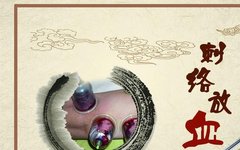
Introduction
The collaterals are an important component of our meridian system. Bloodletting therapy is a unique acupuncture technique in Traditional Chinese Medicine (TCM), with extensive records of its application in the "Huangdi Neijing" (Yellow Emperor's Inner Canon).
Research indicates that bloodletting therapy has a beneficial bidirectional regulatory effect on the blood system. This technique can promote metabolism, improve microcirculation and vascular function, facilitate the elimination of harmful substances from the blood, and ensure that beneficial substances are timely replenished into the bloodstream. By enhancing microcirculation, it can also prevent excessive inflammatory responses and promote recovery from inflammation.
(As stated: This is what TCM refers to as "removing stasis to generate new"; if the old does not go, the new cannot come.)
01
Clinical Examples
Clinical Case 1: Anxiety
Mr. Li, 33 years old, overweight, has been under immense work pressure for a long time, feeling anxious and restless, nearly on the verge of collapse. Upon meridian observation, stagnation was noted near the Zhongchong (中冲) point on the dorsal side of the first segment of the middle finger, with small blue veins bulging and twisting. After puncturing, a significant amount of dark blood was released, and he felt refreshed, with most of his symptoms alleviated. A disposable blood collection needle can be used instead of a three-edged needle.
Clinical Case 2: Nasal Ulcer
Mr. Ji, 36 years old, has a small ulcer in the right nostril that worsens every winter, persisting for many years with unbearable pain and recurrent treatments failing to cure it. Upon meridian examination, several small red blood vessels were found at the Dadu (大敦) and Yinbai (隐白) points of the right big toe. After puncturing, dozens of drops of dark blood were released, and the ulcer receded the next day, with no recurrence for two years.
Clinical Case 3: Oral Ulcer
Mr. Zhao, 50 years old, robust physique, busy with work and socializing, often talks a lot. He is prone to internal heat, prefers cold and fears heat, suffering from recurrent oral ulcers and hoarseness every summer. Upon meridian examination, numerous small red blood vessels were found near the Jing (井) point of the big toe. After several punctures and bloodletting, significant improvement was noted. He has not experienced significant internal heat ulcers in recent years. Additionally, after puncturing and bleeding at points on his back, his hoarseness also improved. Public account: Meridian Acupoint Diagram.
Clinical Case 4: Increased Vaginal Discharge
Ms. Gou has abnormal vaginal discharge that has increased, and various treatments have failed to cure it. Upon meridian examination, several prominent red blood vessels were found at the Lidu (厉兑) point of the second toe. After a small amount of bloodletting, her symptoms improved, and after another session a week later, she was clinically cured.
Clinical Case 5: Sensitivity and Suspicion
Mr. Qian, 26 years old, suffers from neurotic sensitivity and suspicion, often suspecting others of harboring ill intentions or plotting against him. His eyes appear overly bright and exposed. Upon examination, a twisted and angry blood vessel was found near the Shenmen (神门) point on the upper part of the ear. After puncturing, a large amount of stasis blood was released. His gaze became calm, and his suspicious symptoms significantly improved.
It is said that when the disease manifests, the acupoint responds; when the disease resolves, the corresponding stasis blood will gradually disappear. If the disease does not resolve, puncturing can be done every three days until recovery, with bleeding stopping when fresh blood is released, as excessive bleeding is not beneficial.
02
Understanding Health Status Through Blood Color
Which type do you belong to?
1. Dark black blood, resembling ink, indicates a long-standing illness, suggesting stasis blood has been retained for a long time, obstructing the collaterals.
2. Blood mixed with water indicates rheumatism or liver disease.
3. Blood containing jelly-like mucus indicates damp-heat stasis, retained for a long time.
4. Light blood indicates inflammation or an early-stage illness. Purple-red blood indicates a new injury.
5. Blood resembling wash water indicates severe chronic dampness.
6. Clear watery fluid indicates edema.
7. Presence of blisters indicates heavy dampness.
8. Foamy liquid indicates wind pathogen.
9. A large amount of blood indicates a long illness duration.
10. A small amount of blood indicates a short illness duration or deep-seated condition.
11. After cupping, if a hand feels a rush of heat upon entering the cup, it indicates heavy damp-heat.
12. Slow bleeding, even after multiple punctures, indicates qi deficiency and blood deficiency.
13. Light bleeding that does not coagulate easily indicates blood deficiency.
14. Blood that settles quickly and coagulates indicates qi deficiency.
03
Timing of Bloodletting
1. For inflammation and acute pain patients, bloodletting can be done once a day, and after symptoms are alleviated, once every 3-5 days.
2. For chronic patients, once every other day, and after seeing results, once every 5-7 days. Bloodletting can be performed at cupping sites followed by cupping for 15-20 minutes.
04
Contraindications for Bloodletting
1. Patients with significant bleeding or those prone to subcutaneous bleeding.
2. Severe heart disease.
3. Patients with sexually transmitted diseases, skin diseases, or skin ulcers.
4. Pregnant women or those menstruating, and patients with leukemia should not undergo bloodletting.
5. Patients who are overly hungry or full, frightened, or excessively tense should not be treated.
6. For patients with liver disease, bloodletting must be done with caution (as with any other treatment); blood should not come into contact with oneself or open wounds to avoid transmission.
◎ Some images and texts are sourced from the internet, and copyright belongs to the original authors. If there are any issues, please contact us promptly, and we will address them as soon as possible. Thank you!
● Online learning has led to an increase in myopia among adolescents! Online classes: I won't take the blame!
● Babies with recurrent coughs should learn these tips!
● "Text neck" has become a global disease! You may be "murdering" your cervical spine every day…


